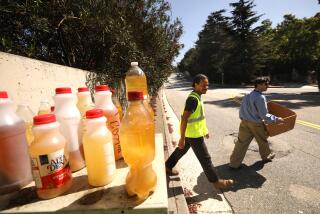COLUMN ONE : Bringing Restrooms to the Street : Budget cuts and crime have closed many public facilities, stranding pedestrians and the homeless. Some cities are trying to restore a basic amenity of urban life.
- Share via
The challenge went out 10 months ago to architects, designers and engineers around the world. Could they meet the elemental human need for a clean and safe restroom capable of withstanding the rigors of American city streets?
The response was staggering, contest organizers say. More than 2,000 people asked for applications, and 309 designs for automatically self-cleaning facilities were sent in by May. To be sure, some were lured by $8,000 in prize money, but most contestants wanted to restore a basic amenity that has nearly disappeared from urban life.
“The need is so apparent. You don’t have to walk very far off a main street to smell the stench in many cities,” said Henry Myerberg, a New York architect who headed judging in the “urban outhouse” contest sponsored by the Vermont Structural Slate Co.
Some entries were lighthearted, like two drawn in the form of giant rolls of toilet paper. Most, though, were in earnest.
“Sure, there is a sort of bathroom humor,” Myerberg said. “But we wanted to send a message that this isn’t a joke. It’s a serious issue that requires a seriousness of thought.”
Indeed, all across the United States, cities are struggling with that distinctly unfunny problem.
As the number of homeless people rises, more streets and alleys reek of human waste. Many public restrooms have closed or are unusable because of vandalism, drug dealing and other crimes. Budget-pinched cities can’t afford to fight back much, or have given up any pretense, such as the decision not to build restrooms in Los Angeles’ new subway system. As a result, private facilities at restaurants and hotels are besieged in many areas.
Now, however, there are signs that some relief may be near. The design contest and a recent exhibit of the best entries at the Urban Center in New York City have generated much attention among city planners nationwide. And, perhaps more important, the first large-scale program in decades to build public restrooms in a U.S. city is expected to begin soon in San Francisco. It will be run by a French company that boasts of having helped in Europe with “95 million flushes.”
Any improvement is welcome, said USC professor Michael Dear, a geographer and urban planning expert who studies downtowns and the homeless. “American cities always have been grossly under-provided with these public conveniences compared to Europe anyway,” he said. Matters worsened in the last decade, he added, as public facilities closed and economic conditions put more people on the street.
To address those problems, San Francisco is negotiating with the JCDecaux company to bring 27 sleek restrooms to the pedestrian-intensive city. For four months last year, New York City successfully tested six Decaux units--computerized affairs with seats that retract into the wall for disinfection after each use and doors that pop open if a person lingers. With permanent installation uncertain in New York, San Francisco is expected to be the first U.S. city to give the new lavatories a real home.
“We are the first, the showcase for many other cities. So we want to make this work,” said Jacob Szeto, the city employee who manages the San Francisco project.
Officials in Los Angeles, San Diego, Seattle, Philadelphia, Washington and elsewhere are watching, particularly because the San Francisco deal is supposed to cost that city nothing. In exchange for placing each pay unit on San Francisco sidewalks, plazas and parks, Decaux would be allowed to place four kiosks and newsstands around the city and rent out advertising space. In addition, users will pay a quarter, although free tokens will be given to the homeless, probably through service agencies and soup kitchens.
Many details of the restrooms and kiosk placement in San Francisco face scrutiny by municipal agencies. Much debate is expected about adding advertising to cluttered streets. But because all the proposed units are wheelchair-accessible, San Francisco avoided the bruising arguments New Yorkers had over the rights of the disabled to use all public facilities.
San Francisco officials hope that the first units will be hooked up to sewer lines this winter. Likely locations include the Civic Center, Market Street in the financial district, Fisherman’s Wharf, Union Square and at the cable car turntable on Powell Street. “We feel there is a definite need,” said Carolyn Dee, executive director of the Downtown Assn. of San Francisco. “It will be a nice convenience for business people and tourists.”
Restaurateurs near San Francisco’s touristy waterfront expect the new facilities to ease the burden of non-customers asking to use the facilities. “We try to be accommodating, but at the same time we want to keep the riffraff out,” said one restaurant manager, who asked not to be identified.
In Laguna Beach, the scarcity of public restrooms prompted the formation of a “Potty Committee” about two years ago. The committee has won municipal approval for a restroom to be built in a downtown parking lot. It is expected to open by next summer, a city official said.
Its sprawl and automobile orientation make the Los Angeles area less adaptable to street restrooms than San Francisco or New York, said Gary Sherwin, spokesman for the Los Angeles Convention and Visitors Bureau. Still, he suggested that they could be useful in parts of Downtown, Hollywood and Santa Monica.
Allyne Winderman, a planner for the Los Angeles Community Redevelopment Agency, recalls happily using Decaux units in Paris a few years ago and even taking photos of one, amusing passersby. “I can’t see any reason why it wouldn’t work in L.A.,” she said. “I think it would be a real amenity for visitors and tourists, so they don’t have to barge into Bullock’s trying to find a bathroom.”
San Francisco’s plan runs counter to a national trend, said Rita Schwartz, who had the unusual assignment of visiting restrooms in 30 U.S. cities’ transit systems three years ago. “The general trend is to close them off, to cut them back, or not to include them if you are building,” said Schwartz, an official with the Port Authority of New York and New Jersey.
But downsides are apparent--not just among the homeless. Middle-class people--mainly men--increasingly use alleys, bushes and doorways, Schwartz said, explaining: “I won’t say it’s a decay of society. It’s more ‘What the hell, I’ve got to go.’ It is just more noticeable. It’s just happening more.”
Ken Eichenbaum, a Milwaukee businessman, was so annoyed by his own desperate searches he wrote a guidebook, “The Toilets of New York,” that tells readers where to find clean and friendly restrooms in museums, hotels, restaurants and parks. Vicki Rovere, author of another recent book, “Where to Go: A Guide to Manhattan’s Toilets,” said the lack of public restrooms forces people into “indignities.”
The issue of public restrooms in Los Angeles and elsewhere is linked to controversies about facilities for the homeless. Related concerns about hygiene, crime and vandalism remain strong in this era of mean streets.
Callie Rogers said she would gladly use the new public facilities if they come to Los Angeles. Homeless and 66 years old, she has become adept, she said, at shielding herself with a blanket at night to relieve herself in Skid Row alleys. During the day, she uses the restrooms in Los Angeles City Hall, at police stations or at LAMP Village, a social service agency on San Pedro Street that with city subsidies also offers showers to street people for 35 cents.
“This city stinks,” said Rogers, barefoot and carrying a shoulder bag and grocery sack filled with her possessions, after a visit to LAMP Village. “We need so many more toilets. If it were up to me and I was on the City Council, I would fight for one on every block.”
A plan to place 33 non-flush portables--the relatively primitive chemical johns seen at construction sites--around Los Angeles’ Skid Row was killed last year by then-Mayor Tom Bradley. Acting on complaints by business owners, Bradley said he feared the units would attract drug dealing and prostitution.
For two months, the city funded supervised round-the-clock restrooms inside a shelter and a Skid Row hotel. Now, the 50-block Skid Row district has no 24-hour public restroom, activists complain.
Alice Callaghan, the strongest voice lobbying for restrooms on Skid Row last year, calls this shortage an assault on human dignity as well as on basic health standards.
Director of the Las Familias Del Pueblo social service agency, she is pleased that the San Francisco project is raising interest, but she worries that the Decaux models are too fancy and complicated for areas with large homeless populations.
“We need to put things that fit with the neighborhood and high-tech won’t fit,” Callaghan said. For example, she said, she fears mentally ill people might try to stuff objects into the plumbing.
Decaux seeks to assuage all sorts of worries with its advanced technology and some tough-minded lobbying. (Its main competitor in San Francisco, Gannett Outdoor Advertising, offers similar units manufactured by an Israeli firm.)
Only 55 seconds after a user leaves, the Decaux model retracts and disinfects the seat as a high-pressure spray cleans the floor. To prevent camping and partying, the doors pop open after 20 minutes; if someone lingers five minutes longer, detectors trigger a siren. An emergency button to 911 telephone lines is built in.
The units, which each cost $130,000 to build, have exteriors of concrete and stainless steel, or concrete and cast iron, in styles that range from Victoriana to modern. Coatings are supposed to be easily stripped of graffiti. In San Francisco, Decaux attendants on motorcycle will check on problems and supplies.
Suzanne Davis, Decaux’s U.S. representative, is demonstrating one of the units in other cities. “When we first talk about it, people giggle,” she said. “Then they start acknowledging to each other that they too had been caught short on the streets.”
In New York’s four-month test, six units were used more than 41,539 times, suffered 12 incidents of minor vandalism and experienced operating problems--such as jammed doors--42 times, according to a city report. Polls showed overwhelming percentages of users were pleased and wanted more units.
The big issue was access for the disabled. Each of the three New York test sites had two models. A roundish model, 5 1/2 feet in diameter, was similar to an airplane bathroom. The other, wheelchair accessible, was an oval structure three times as large.
Decaux contended that it experienced problems with prostitution and drug use in London when the larger units were available to the public. So, in the New York test, entrance to the wheelchair-accessible ones required key cards that were to be available free to the disabled. But after activists charged discrimination, Decaux hired attendants to help out.
Critics now question whether the attendants, not the technology, prevented crime.
San Diego, which has a national reputation for helping the homeless, built street-level bathrooms in its civic center five years ago. The use of attendants limited breakage, fistfights and drinking, parks official Ted Medina said.
To see if the city could save $55,000 a year, supervision was stopped for two weeks recently. “There was high vandalism, breakage, drug use, prostitution, camping in the restroom. Everything you don’t want to hear about,” Medina said. Attendants were put back and the situation turned around.
Times staff writer Kevin Johnson contributed to this report.
More to Read
Sign up for Essential California
The most important California stories and recommendations in your inbox every morning.
You may occasionally receive promotional content from the Los Angeles Times.











